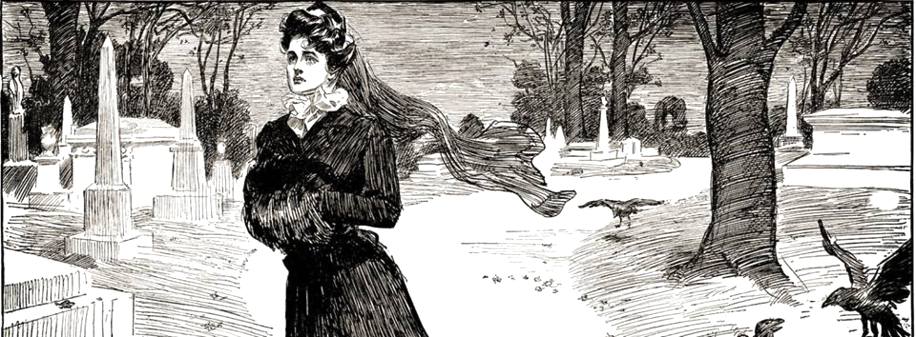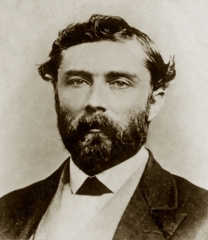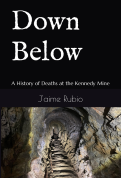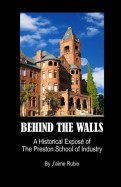
Theodore Judah - The Man That History Forgot ~ "The railroad genius behind Roseville’s birth has become invisible."
Have you ever wondered what life would be like if Roseville didn’t exist? Like the ripples in a pond after a stone hits the water, the effects of one man’s dream can greatly change the path of local history; and in the case of Theodore D. Judah, Roseville’s legacy was forever altered by his quest to bring the Central Pacific Railroad through Placer County.
Often times when people speak of the Central Pacific Railroad, or the amazing feat of building railways for iron horses over the Sierra’s, many refer to the term, “The Big Four.” This group
consisted of Sacramento businessmen, Charles Crocker, Leland Stanford, Mark Hopkins and Collis P. Huntington. Yet a truth that is often omitted is the fact that without one key individual, Judah,
there wouldn’t have been a Central Pacific Railroad in the first place.
A native of Massachusetts, Judah grew up quickly, showing he had the intellect of a creative genius. By the time he was only 11-years-old, Judah was permitted to attend college preparatory
courses at Rensselaer Polytechnic Institute. It was there that Judah became fascinated with railroads by way of professor and avid railroad enthusiast, Mr. Amos Eaton. By the time Judah finished
college he was hired as a surveyor’s assistant with Schenectady & Troy Railroad, and then went on to work on the Buffalo & New York lines. During this time Judah’s primary job was acting as
an engineer on the Niagara Gorge.
Even before traveling to California, Judah had a growing passion to see the Sierras. He’d always imagined a way to build a transcontinental railroad that could cross over the mountain pass. Many
thought the idea was daft, even nicknaming him “Crazy Judah.”
When he came to California in 1854 to help build the Sacramento Valley Railroad he still held on to the idea. After his work with SVR was completed, he decided to stay in Northern California to
work on his own vision. He spent several years surveying the Sierras, searching for possible access routes to create this “dream railway.” By 1860 Judah had decided that the old Donner Pass would be
the best way to go. He eventually approached the right investors — “The Big Four.”
Judah won over the railroad barons by showing them that they would profit greatly from a railway snaking up to the mining camps in Nevada. After selling the idea, the Central Pacific Railroad
Company was created in 1861. Once “The Big Four” were on board, the political backing came swiftly as well. As soon as the idea of a transcontinental railroad was brought up to President Lincoln he
felt it would prove beneficial for the Union forces in the Civil War.
By July 1, 1862, the Pacific Railroad Act, originally given the labours title “An act to aid in the construction of a railroad and telegraph line from the Missouri river to the Pacific ocean,
and to secure to the government the use of the same for postal, military, and other purposes,” was signed into law. The maneuver allowed the first transcontinental railroad to be built based on land
grants and government loan bonds. In order for Central Pacific to qualify for any government bonds or grants its first 40 miles of track had to be bankrolled and completed by The Big Four. Crocker,
Stanford, Huntington and Hopkins put their own fortunes on the line to finance it, and it paid off.
Although the Central Pacific broke ground in Sacramento, it wasn’t until it had reached the first 18 miles that the railroad was technically on the base of the Sierras. According to geologist
Josiah Whitney, the Sierra foothills started in the area where Roseville is today. The location became crucial to Judah: He saw it as the best place to make a centralized freight terminal. As soon as
the railroad made its way to Tobias Grider’s ranch, it intersected with California Central Railway, creating a junction. The new city of Roseville sprang up on that spot like a wild rose. By April
26, 1864, daily trains began running from Sacramento to the junction in the city.
Although Judah wanted to see that Roseville had the main railroad facility in Placer County, he did not live long enough to make it happen. “The Big Four” opted to instead choose Rocklin to
build their roundhouse.
Towards the end, it is said that Judah felt the heads of Central Pacific were only interested in putting money into their pockets, and cared little about the quality or integrity of the actual
railroad. Judah planned to seek financial assistance to buy out the original four investors. During his passage back to New York via the Isthmus of Panama, Judah fell ill with Yellow Fever and passed
away one week after his arrival: It was Nov. 2, 1863. The Sacramento Daily News reported of Judah’s death the following day, writing, “No man has been so intimately connected with the Pacific
Railroad, in California, as T.D. Judah.”
While the railroad continued on without him, “The Big Four” used Judah’s plans and ideas as their own. On May 10, 1869, the Central Pacific and Union Pacific railways connected at a ceremony in
Promontory, Utah, where the “Golden Spike” was driven into the ground. Sadly, the widow of the very man who envisioned this moment and designed that very railroad was not present at the event. Some
accounts say Judah’s wife was not even afforded an invitation. Later, Anne Judah spoke in her own words about the Golden Spike, saying, “It seemed as though the spirit of my dead husband descended on
me and together we were there unseen and unheard of by man.”
Judah was never able to see his dream to the finish line. No, just as his wife said, he was “unseen and unheard of by man” — literally forgotten and erased without any mention or honor to what
great achievements in history he made. It is safe to say that without Theodore Judah, there would never have been a Central Pacific Railroad, just as there might never have been a
Roseville.
-- J'aime Rubio
(Originally published on February 27, 2015 by the Roseville Press-Tribune)
Photo: Archived Photo/Public Domain





